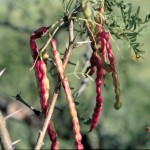Western honey mesquite
Prosopis glandulosa Torr. var. torreyana (Benson) M.C. Johnst.
Fabaceae (Legume family)
Description
This variety of common honey mesquite is found in the Trans-Pecos region of Texas. A member of the Legume family, western honey mesquite generally reaches 2 to 4 feet tall and is multi-stemmed. The two varieties of Prosopis glandulosa hybridize readily, and the plants may contain characteristics of each.
The leaves are composed of five to 20 pairs of leaflets that are much smaller than those of common honey mesquite. They are opposite, or situated in pairs across from each other along the stem. The plant also has opposite thorns at each node.
Its flowers can appear throughout the summer months, depending on rainfall. The long, narrow bean pods develop and fall to the ground during late summer to fall.
The forage value of western honey mesquite is poor for livestock and wildlife except that the beans are consumed by both.
Habitat
Western honey mesquite grows in dry native ranges mainly west of the Pecos River in Texas.
Images
Plant Characteristics
Flower Color: Yellow
Seed Type: Bean/Pod
Duration: Perennial
Stem Texture: Prickly, Spiny, or Thorny
Growth Habit: Shrub (Woody)
Leaf Shape
 : Bipinnately Compound
: Bipinnately Compound
Season: Warm
Distribution
 : 07 - Edwards Plateau
: 07 - Edwards Plateau
Distributions
Distribution refers to the ecological region in Texas that a plant has been found. You can also view a clickable map.
Book: Brush and Weeds of Texas Rangelands (B-6208)
Collection: Brush and Weeds





